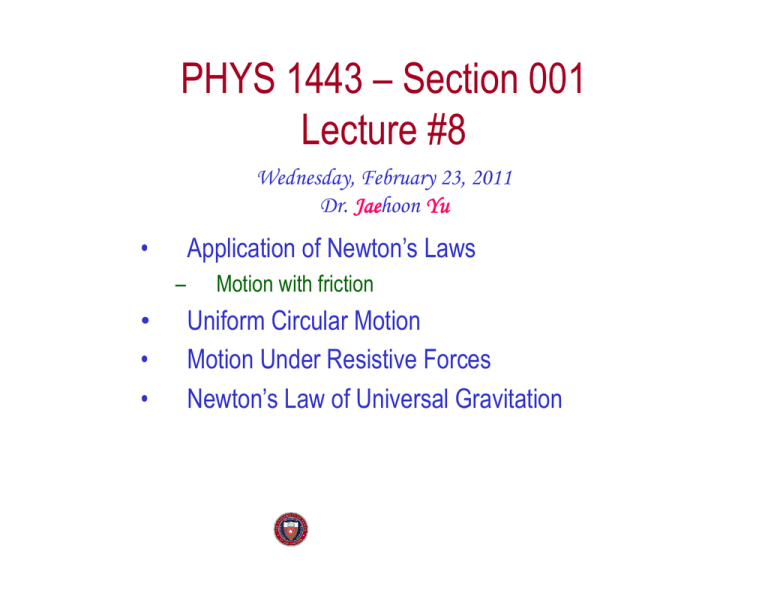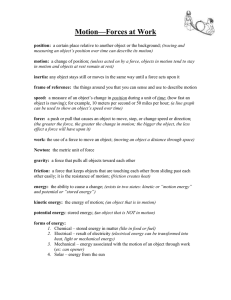Wednesday, Feb. 23, 2011
advertisement

PHYS 1443 – Section 001 Lecture #8 Wednesday, February 23, 2011 Dr. Jaehoon Yu • Application of Newton’s Laws – • • • Motion with friction Uniform Circular Motion Motion Under Resistive Forces Newton’s Law of Universal Gravitation Announcements • Mid-term comprehensive exam – 1 – 2:20pm, Monday, Mar. 7, SH103 – Covers: CH.1.1 through what we complete next Wednesday, Mar. 2 plus Appendix • Reading assignment – Read CH5.1, 5.5 and 5.6 and follow through example problems in the chapters • Colloquium this week: Our own Dr. C. Jackson on “Race to God Particle” Wednesday, Feb. 23, 2011 PHYS 1443-001, Spring 2011 Dr. Jaehoon Yu 2 Wednesday, Feb. 23, 2011 PHYS 1443-001, Spring 2011 Dr. Jaehoon Yu 3 Reminder: Special Project for Extra Credit A large man and a small boy stand facing each other on frictionless ice. They put their hands together and push against each other so that they move apart. a) Who moves away with the higher speed, by how much and why? b) Who moves farther in the same elapsed time, by how much and why? • Derive the formulae for the two problems above in much more detail and explain your logic in a greater detail than what is in this lecture note. • Be sure to clearly define each variables used in your derivation. • Each problem is 10 points. • Due is Wednesday, Mar. 2. Wednesday, Feb. 23, 2011 PHYS 1443-001, Spring 2011 Dr. Jaehoon Yu 4 Friction Force When an object is in contact with a surface there is a force acting on that object. The component of this force that is parallel to the surface is called the friction force. This resistive force is exerted on a moving object due to viscosity or other types of frictional property of the medium in or surface on which the object moves. Always opposite to the movement!! Wednesday, Feb. 23, 2011 PHYS 1443-001, Spring 2011 Dr. Jaehoon Yu 5 Static Friction Wednesday, Feb. 23, 2011 PHYS 1443-001, Spring 2011 Dr. Jaehoon Yu 6 Magnitude of the Static Friction The magnitude of the static friction force can have any value from zero up to the maximum value. is called the coefficient of static friction. What is the unit? None Once the object starts moving, there is NO MORE static friction!! Kinetic friction applies during the move!! PHYS 1443-001, Spring 2011 Wednesday, Feb. 23, 2011 Dr. Jaehoon Yu 7 Note that the magnitude of the frictional force does not depend on the contact area of the surfaces. Wednesday, Feb. 23, 2011 PHYS 1443-001, Spring 2011 Dr. Jaehoon Yu 8 Kinetic Friction Static friction opposes the impending relative motion between two objects. Kinetic friction opposes the relative sliding motions that is happening. The resistive force exerted on the object during its movement. Normally much smaller than static friction!! is called the coefficient of kinetic friction. What is the direction of friction forces? Wednesday, Feb. 23, 2011 opposite to the movement PHYS 1443-001, Spring 2011 Dr. Jaehoon Yu 9 Figure 5.3 Friction Force vs Applied Force Coefficients of Friction What are these? Wednesday, Feb. 23, 2011 PHYS 1443-001, Spring 2011 Dr. Jaehoon Yu 11 Forces of Friction Summary Resistive force exerted on a moving object due to viscosity or other types frictional property of the medium in or surface on which the object moves. These forces are either proportional to the velocity or the normal force. Force of static friction, fs: The resistive force exerted on the object until just before the beginning of its movement Empirical Formula f s ≤ µs F N What does this formula tell you? Frictional force increases till it reaches the limit!! Beyond the limit, the object moves, and there is NO MORE static friction but the kinetic friction takes it over. Force of kinetic friction, fk f k = µk F N The resistive force exerted on the object during its movement Which direction does kinetic friction apply? Wednesday, Feb. 23, 2011 PHYS 1443-001, Spring 2011 Dr. Jaehoon Yu Opposite to the motion! 12 Look at this problem again… Suppose you are pulling a box on a rough surfice, using a rope. M Free-body diagram n= -Fg Ff T Fg=Mg What are the forces being exerted on the box? T Gravitational force: Fg Normal force: n Tension force: T Friction force: Ff n= -Fg T Ff Fg=Mg Total force: F=Fg+n+T+Ff If T is a constant force, ax, is constant Wednesday, Feb. 23, 2011 T − Ff = Max ax = T − Ff M −Fg + n = n = Fg ⎛ T − Ff ⎞ t ⎝ M ⎟⎠ vxi + ax t = vxi + ⎜ x f − xi = vxi t + 1 ⎛⎜ T − Ff ⎞⎟ t 2 PHYS 1443-001, Spring 2011 Dr. Jaehoon Yu 2⎝ M ⎠ 13 Example 4.16 w/ Friction Suppose a block is placed on a rough surface inclined relative to the horizontal. The inclination angle is increased till the block starts to move. Show that by measuring this critical angle, θc, one can determine coefficient of static friction, µs. fs=µsn y n Free-body Diagram Fg n fs=µsn x θ θ Net force F = Ma = Fg + n + f s Fgx − fs = Mg sin θ − fs = x comp. F= -Mg fs = µ s n = y comp. µs = Wednesday, Feb. 23, 2011 PHYS 1443-001, Spring 2011 Dr. Jaehoon Yu 14
